LAW011-1 Business Law Assignment: Contract, Tort, Business Medium
VerifiedAdded on 2022/12/08
|9
|3285
|397
Homework Assignment
AI Summary
This business law assignment addresses legal issues faced by Ringo, the owner of Elixir Gardens. The first part analyzes contract law, specifically focusing on the elements of a valid contract and applying these principles to a scenario involving a social agreement between family members. The second part delves into tort law, examining negligence claims. It outlines the essential conditions for establishing negligence, including duty of care, breach of duty, causation, and damages, and explores the concept of vicarious liability. The final part explores different business mediums available to Ringo and his friends, comparing the advantages and disadvantages of each, with a focus on the corporate structure and its implications. The assignment provides a comprehensive analysis of legal concepts within a business context.

LAW FOR BUSINESS MANAGEMENT
Paraphrase This Document
Need a fresh take? Get an instant paraphrase of this document with our AI Paraphraser
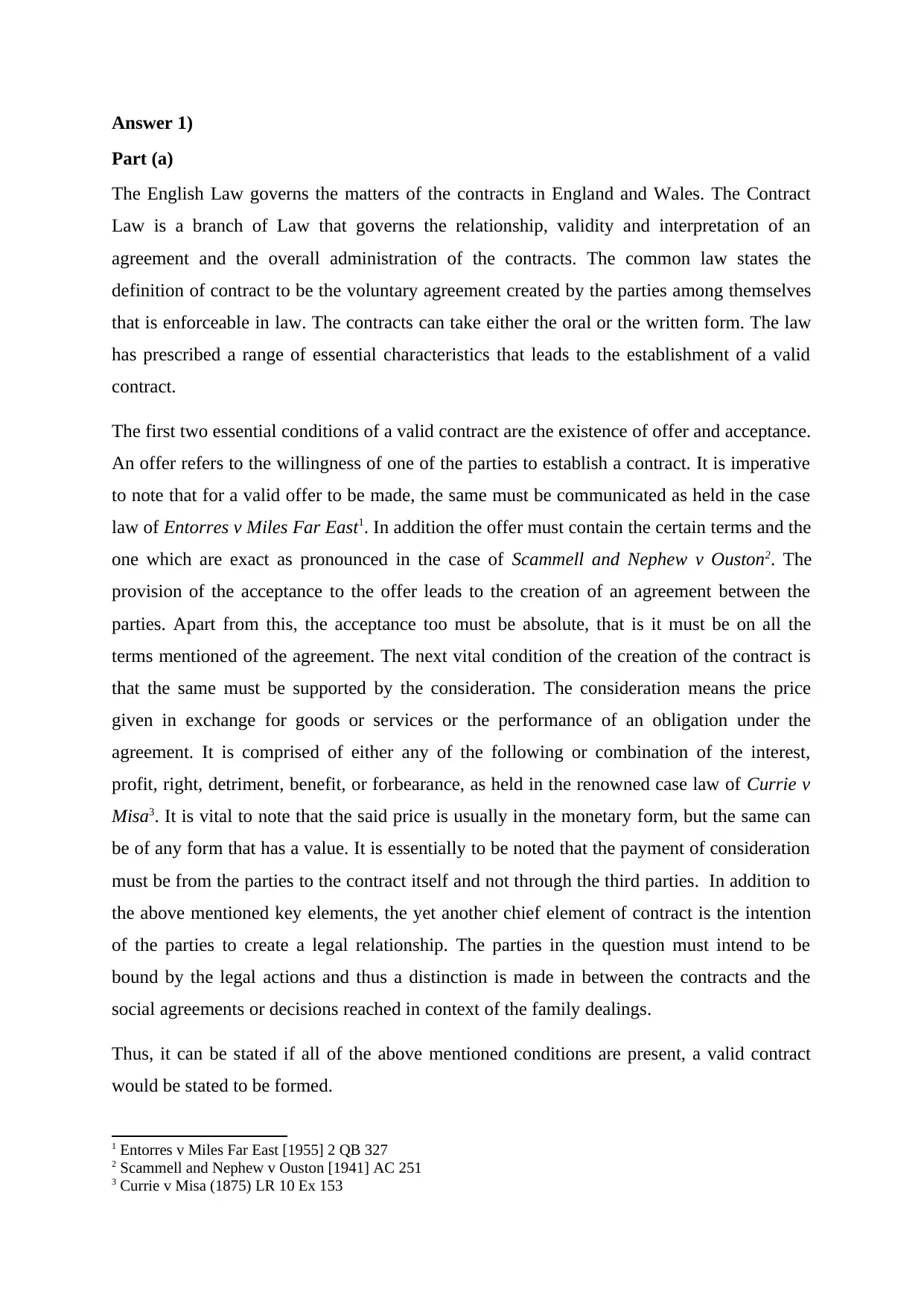
Answer 1)
Part (a)
The English Law governs the matters of the contracts in England and Wales. The Contract
Law is a branch of Law that governs the relationship, validity and interpretation of an
agreement and the overall administration of the contracts. The common law states the
definition of contract to be the voluntary agreement created by the parties among themselves
that is enforceable in law. The contracts can take either the oral or the written form. The law
has prescribed a range of essential characteristics that leads to the establishment of a valid
contract.
The first two essential conditions of a valid contract are the existence of offer and acceptance.
An offer refers to the willingness of one of the parties to establish a contract. It is imperative
to note that for a valid offer to be made, the same must be communicated as held in the case
law of Entorres v Miles Far East1. In addition the offer must contain the certain terms and the
one which are exact as pronounced in the case of Scammell and Nephew v Ouston2. The
provision of the acceptance to the offer leads to the creation of an agreement between the
parties. Apart from this, the acceptance too must be absolute, that is it must be on all the
terms mentioned of the agreement. The next vital condition of the creation of the contract is
that the same must be supported by the consideration. The consideration means the price
given in exchange for goods or services or the performance of an obligation under the
agreement. It is comprised of either any of the following or combination of the interest,
profit, right, detriment, benefit, or forbearance, as held in the renowned case law of Currie v
Misa3. It is vital to note that the said price is usually in the monetary form, but the same can
be of any form that has a value. It is essentially to be noted that the payment of consideration
must be from the parties to the contract itself and not through the third parties. In addition to
the above mentioned key elements, the yet another chief element of contract is the intention
of the parties to create a legal relationship. The parties in the question must intend to be
bound by the legal actions and thus a distinction is made in between the contracts and the
social agreements or decisions reached in context of the family dealings.
Thus, it can be stated if all of the above mentioned conditions are present, a valid contract
would be stated to be formed.
1 Entorres v Miles Far East [1955] 2 QB 327
2 Scammell and Nephew v Ouston [1941] AC 251
3 Currie v Misa (1875) LR 10 Ex 153
Part (a)
The English Law governs the matters of the contracts in England and Wales. The Contract
Law is a branch of Law that governs the relationship, validity and interpretation of an
agreement and the overall administration of the contracts. The common law states the
definition of contract to be the voluntary agreement created by the parties among themselves
that is enforceable in law. The contracts can take either the oral or the written form. The law
has prescribed a range of essential characteristics that leads to the establishment of a valid
contract.
The first two essential conditions of a valid contract are the existence of offer and acceptance.
An offer refers to the willingness of one of the parties to establish a contract. It is imperative
to note that for a valid offer to be made, the same must be communicated as held in the case
law of Entorres v Miles Far East1. In addition the offer must contain the certain terms and the
one which are exact as pronounced in the case of Scammell and Nephew v Ouston2. The
provision of the acceptance to the offer leads to the creation of an agreement between the
parties. Apart from this, the acceptance too must be absolute, that is it must be on all the
terms mentioned of the agreement. The next vital condition of the creation of the contract is
that the same must be supported by the consideration. The consideration means the price
given in exchange for goods or services or the performance of an obligation under the
agreement. It is comprised of either any of the following or combination of the interest,
profit, right, detriment, benefit, or forbearance, as held in the renowned case law of Currie v
Misa3. It is vital to note that the said price is usually in the monetary form, but the same can
be of any form that has a value. It is essentially to be noted that the payment of consideration
must be from the parties to the contract itself and not through the third parties. In addition to
the above mentioned key elements, the yet another chief element of contract is the intention
of the parties to create a legal relationship. The parties in the question must intend to be
bound by the legal actions and thus a distinction is made in between the contracts and the
social agreements or decisions reached in context of the family dealings.
Thus, it can be stated if all of the above mentioned conditions are present, a valid contract
would be stated to be formed.
1 Entorres v Miles Far East [1955] 2 QB 327
2 Scammell and Nephew v Ouston [1941] AC 251
3 Currie v Misa (1875) LR 10 Ex 153
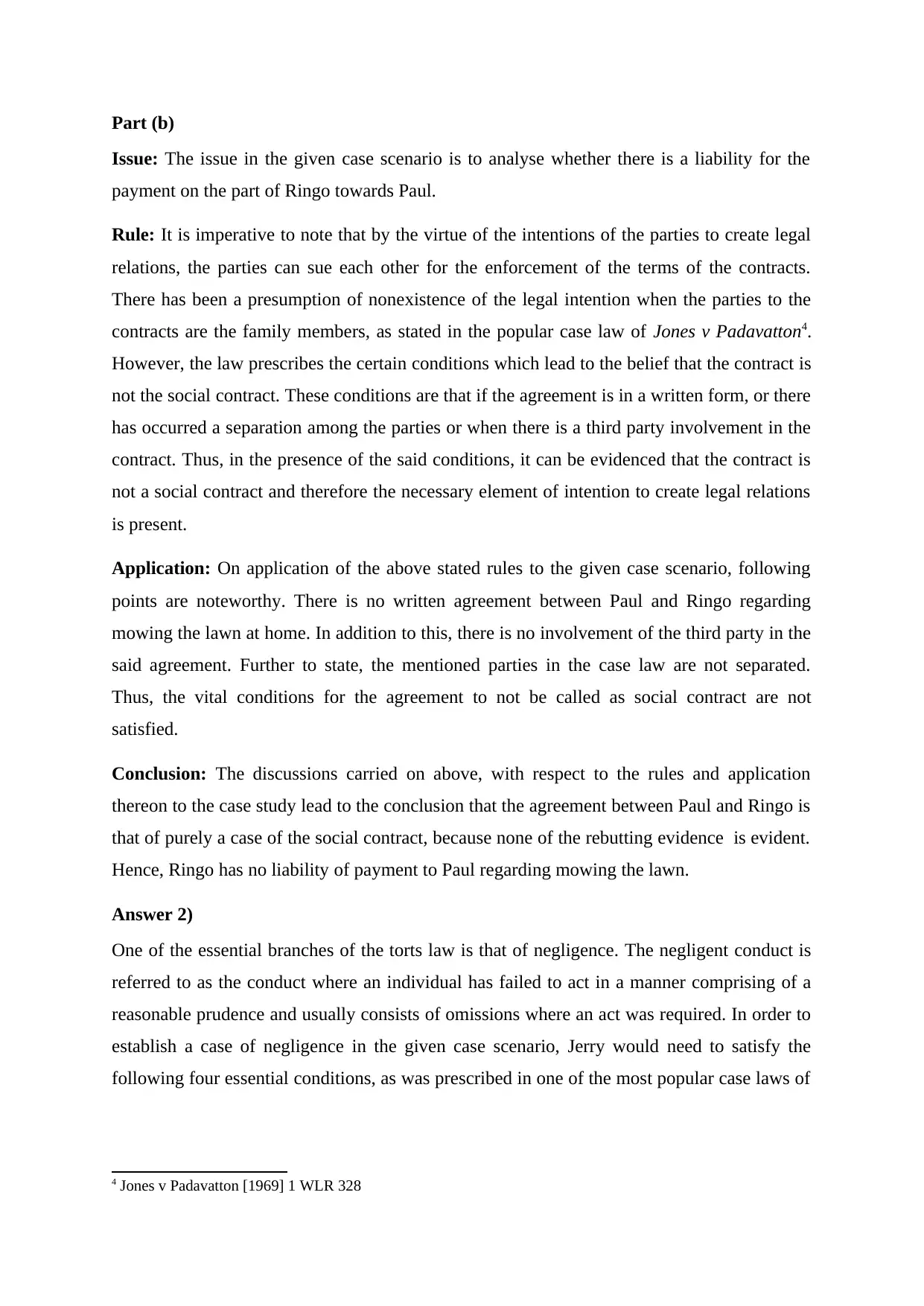
Part (b)
Issue: The issue in the given case scenario is to analyse whether there is a liability for the
payment on the part of Ringo towards Paul.
Rule: It is imperative to note that by the virtue of the intentions of the parties to create legal
relations, the parties can sue each other for the enforcement of the terms of the contracts.
There has been a presumption of nonexistence of the legal intention when the parties to the
contracts are the family members, as stated in the popular case law of Jones v Padavatton4.
However, the law prescribes the certain conditions which lead to the belief that the contract is
not the social contract. These conditions are that if the agreement is in a written form, or there
has occurred a separation among the parties or when there is a third party involvement in the
contract. Thus, in the presence of the said conditions, it can be evidenced that the contract is
not a social contract and therefore the necessary element of intention to create legal relations
is present.
Application: On application of the above stated rules to the given case scenario, following
points are noteworthy. There is no written agreement between Paul and Ringo regarding
mowing the lawn at home. In addition to this, there is no involvement of the third party in the
said agreement. Further to state, the mentioned parties in the case law are not separated.
Thus, the vital conditions for the agreement to not be called as social contract are not
satisfied.
Conclusion: The discussions carried on above, with respect to the rules and application
thereon to the case study lead to the conclusion that the agreement between Paul and Ringo is
that of purely a case of the social contract, because none of the rebutting evidence is evident.
Hence, Ringo has no liability of payment to Paul regarding mowing the lawn.
Answer 2)
One of the essential branches of the torts law is that of negligence. The negligent conduct is
referred to as the conduct where an individual has failed to act in a manner comprising of a
reasonable prudence and usually consists of omissions where an act was required. In order to
establish a case of negligence in the given case scenario, Jerry would need to satisfy the
following four essential conditions, as was prescribed in one of the most popular case laws of
4 Jones v Padavatton [1969] 1 WLR 328
Issue: The issue in the given case scenario is to analyse whether there is a liability for the
payment on the part of Ringo towards Paul.
Rule: It is imperative to note that by the virtue of the intentions of the parties to create legal
relations, the parties can sue each other for the enforcement of the terms of the contracts.
There has been a presumption of nonexistence of the legal intention when the parties to the
contracts are the family members, as stated in the popular case law of Jones v Padavatton4.
However, the law prescribes the certain conditions which lead to the belief that the contract is
not the social contract. These conditions are that if the agreement is in a written form, or there
has occurred a separation among the parties or when there is a third party involvement in the
contract. Thus, in the presence of the said conditions, it can be evidenced that the contract is
not a social contract and therefore the necessary element of intention to create legal relations
is present.
Application: On application of the above stated rules to the given case scenario, following
points are noteworthy. There is no written agreement between Paul and Ringo regarding
mowing the lawn at home. In addition to this, there is no involvement of the third party in the
said agreement. Further to state, the mentioned parties in the case law are not separated.
Thus, the vital conditions for the agreement to not be called as social contract are not
satisfied.
Conclusion: The discussions carried on above, with respect to the rules and application
thereon to the case study lead to the conclusion that the agreement between Paul and Ringo is
that of purely a case of the social contract, because none of the rebutting evidence is evident.
Hence, Ringo has no liability of payment to Paul regarding mowing the lawn.
Answer 2)
One of the essential branches of the torts law is that of negligence. The negligent conduct is
referred to as the conduct where an individual has failed to act in a manner comprising of a
reasonable prudence and usually consists of omissions where an act was required. In order to
establish a case of negligence in the given case scenario, Jerry would need to satisfy the
following four essential conditions, as was prescribed in one of the most popular case laws of
4 Jones v Padavatton [1969] 1 WLR 328
⊘ This is a preview!⊘
Do you want full access?
Subscribe today to unlock all pages.

Trusted by 1+ million students worldwide
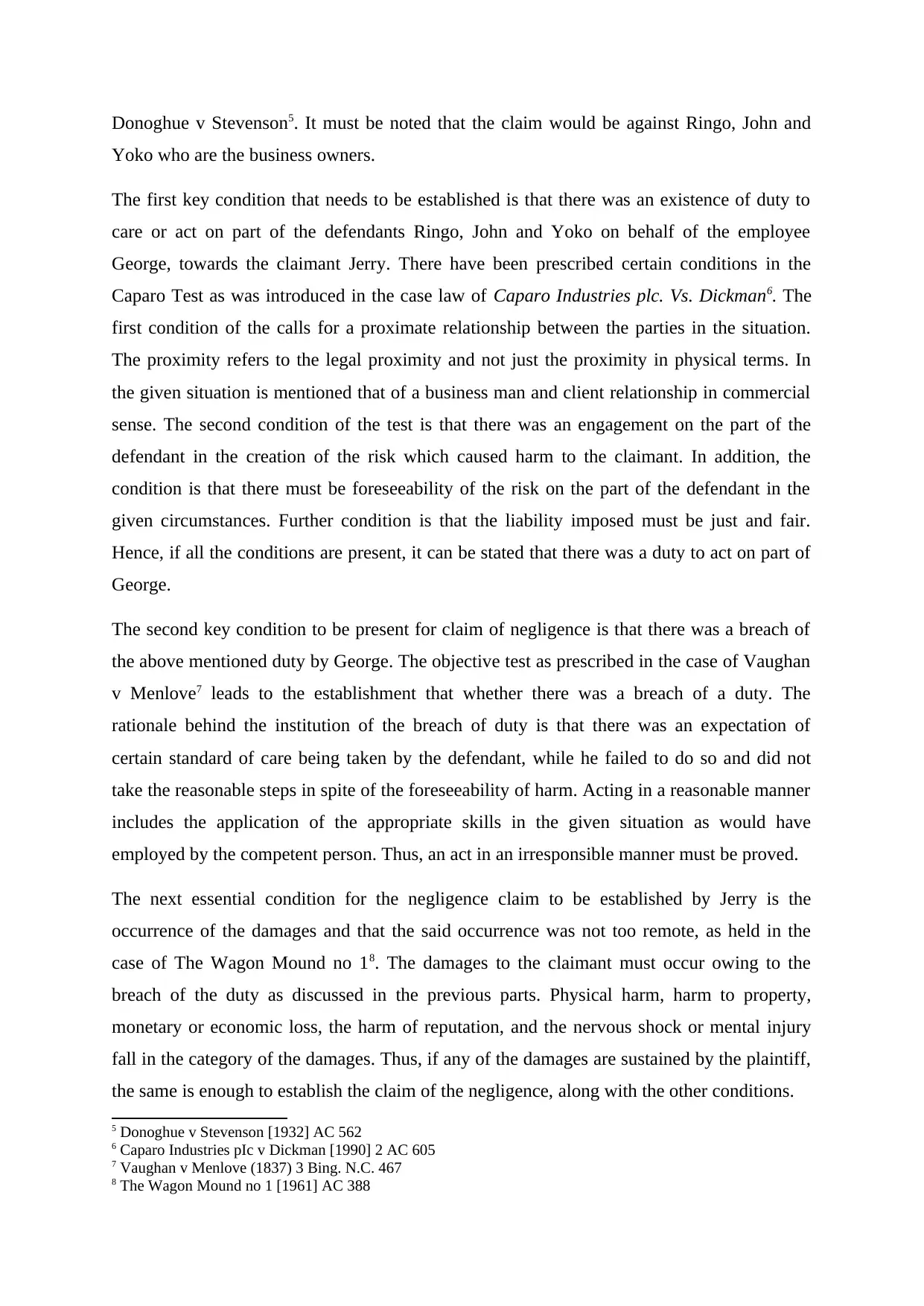
Donoghue v Stevenson5. It must be noted that the claim would be against Ringo, John and
Yoko who are the business owners.
The first key condition that needs to be established is that there was an existence of duty to
care or act on part of the defendants Ringo, John and Yoko on behalf of the employee
George, towards the claimant Jerry. There have been prescribed certain conditions in the
Caparo Test as was introduced in the case law of Caparo Industries plc. Vs. Dickman6. The
first condition of the calls for a proximate relationship between the parties in the situation.
The proximity refers to the legal proximity and not just the proximity in physical terms. In
the given situation is mentioned that of a business man and client relationship in commercial
sense. The second condition of the test is that there was an engagement on the part of the
defendant in the creation of the risk which caused harm to the claimant. In addition, the
condition is that there must be foreseeability of the risk on the part of the defendant in the
given circumstances. Further condition is that the liability imposed must be just and fair.
Hence, if all the conditions are present, it can be stated that there was a duty to act on part of
George.
The second key condition to be present for claim of negligence is that there was a breach of
the above mentioned duty by George. The objective test as prescribed in the case of Vaughan
v Menlove7 leads to the establishment that whether there was a breach of a duty. The
rationale behind the institution of the breach of duty is that there was an expectation of
certain standard of care being taken by the defendant, while he failed to do so and did not
take the reasonable steps in spite of the foreseeability of harm. Acting in a reasonable manner
includes the application of the appropriate skills in the given situation as would have
employed by the competent person. Thus, an act in an irresponsible manner must be proved.
The next essential condition for the negligence claim to be established by Jerry is the
occurrence of the damages and that the said occurrence was not too remote, as held in the
case of The Wagon Mound no 18. The damages to the claimant must occur owing to the
breach of the duty as discussed in the previous parts. Physical harm, harm to property,
monetary or economic loss, the harm of reputation, and the nervous shock or mental injury
fall in the category of the damages. Thus, if any of the damages are sustained by the plaintiff,
the same is enough to establish the claim of the negligence, along with the other conditions.
5 Donoghue v Stevenson [1932] AC 562
6 Caparo Industries pIc v Dickman [1990] 2 AC 605
7 Vaughan v Menlove (1837) 3 Bing. N.C. 467
8 The Wagon Mound no 1 [1961] AC 388
Yoko who are the business owners.
The first key condition that needs to be established is that there was an existence of duty to
care or act on part of the defendants Ringo, John and Yoko on behalf of the employee
George, towards the claimant Jerry. There have been prescribed certain conditions in the
Caparo Test as was introduced in the case law of Caparo Industries plc. Vs. Dickman6. The
first condition of the calls for a proximate relationship between the parties in the situation.
The proximity refers to the legal proximity and not just the proximity in physical terms. In
the given situation is mentioned that of a business man and client relationship in commercial
sense. The second condition of the test is that there was an engagement on the part of the
defendant in the creation of the risk which caused harm to the claimant. In addition, the
condition is that there must be foreseeability of the risk on the part of the defendant in the
given circumstances. Further condition is that the liability imposed must be just and fair.
Hence, if all the conditions are present, it can be stated that there was a duty to act on part of
George.
The second key condition to be present for claim of negligence is that there was a breach of
the above mentioned duty by George. The objective test as prescribed in the case of Vaughan
v Menlove7 leads to the establishment that whether there was a breach of a duty. The
rationale behind the institution of the breach of duty is that there was an expectation of
certain standard of care being taken by the defendant, while he failed to do so and did not
take the reasonable steps in spite of the foreseeability of harm. Acting in a reasonable manner
includes the application of the appropriate skills in the given situation as would have
employed by the competent person. Thus, an act in an irresponsible manner must be proved.
The next essential condition for the negligence claim to be established by Jerry is the
occurrence of the damages and that the said occurrence was not too remote, as held in the
case of The Wagon Mound no 18. The damages to the claimant must occur owing to the
breach of the duty as discussed in the previous parts. Physical harm, harm to property,
monetary or economic loss, the harm of reputation, and the nervous shock or mental injury
fall in the category of the damages. Thus, if any of the damages are sustained by the plaintiff,
the same is enough to establish the claim of the negligence, along with the other conditions.
5 Donoghue v Stevenson [1932] AC 562
6 Caparo Industries pIc v Dickman [1990] 2 AC 605
7 Vaughan v Menlove (1837) 3 Bing. N.C. 467
8 The Wagon Mound no 1 [1961] AC 388
Paraphrase This Document
Need a fresh take? Get an instant paraphrase of this document with our AI Paraphraser
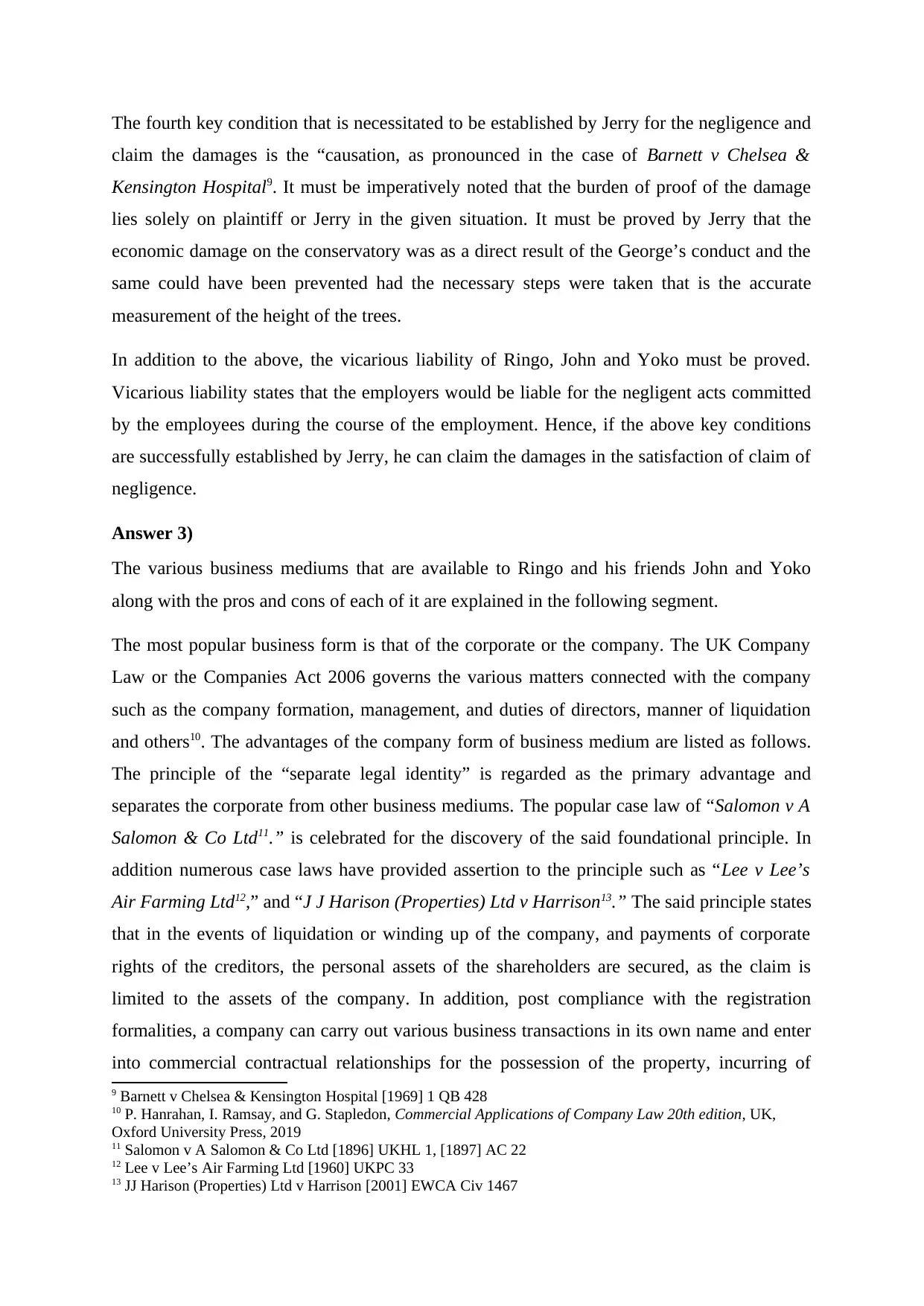
The fourth key condition that is necessitated to be established by Jerry for the negligence and
claim the damages is the “causation, as pronounced in the case of Barnett v Chelsea &
Kensington Hospital9. It must be imperatively noted that the burden of proof of the damage
lies solely on plaintiff or Jerry in the given situation. It must be proved by Jerry that the
economic damage on the conservatory was as a direct result of the George’s conduct and the
same could have been prevented had the necessary steps were taken that is the accurate
measurement of the height of the trees.
In addition to the above, the vicarious liability of Ringo, John and Yoko must be proved.
Vicarious liability states that the employers would be liable for the negligent acts committed
by the employees during the course of the employment. Hence, if the above key conditions
are successfully established by Jerry, he can claim the damages in the satisfaction of claim of
negligence.
Answer 3)
The various business mediums that are available to Ringo and his friends John and Yoko
along with the pros and cons of each of it are explained in the following segment.
The most popular business form is that of the corporate or the company. The UK Company
Law or the Companies Act 2006 governs the various matters connected with the company
such as the company formation, management, and duties of directors, manner of liquidation
and others10. The advantages of the company form of business medium are listed as follows.
The principle of the “separate legal identity” is regarded as the primary advantage and
separates the corporate from other business mediums. The popular case law of “Salomon v A
Salomon & Co Ltd11.” is celebrated for the discovery of the said foundational principle. In
addition numerous case laws have provided assertion to the principle such as “Lee v Lee’s
Air Farming Ltd12,” and “J J Harison (Properties) Ltd v Harrison13.” The said principle states
that in the events of liquidation or winding up of the company, and payments of corporate
rights of the creditors, the personal assets of the shareholders are secured, as the claim is
limited to the assets of the company. In addition, post compliance with the registration
formalities, a company can carry out various business transactions in its own name and enter
into commercial contractual relationships for the possession of the property, incurring of
9 Barnett v Chelsea & Kensington Hospital [1969] 1 QB 428
10 P. Hanrahan, I. Ramsay, and G. Stapledon, Commercial Applications of Company Law 20th edition, UK,
Oxford University Press, 2019
11 Salomon v A Salomon & Co Ltd [1896] UKHL 1, [1897] AC 22
12 Lee v Lee’s Air Farming Ltd [1960] UKPC 33
13 JJ Harison (Properties) Ltd v Harrison [2001] EWCA Civ 1467
claim the damages is the “causation, as pronounced in the case of Barnett v Chelsea &
Kensington Hospital9. It must be imperatively noted that the burden of proof of the damage
lies solely on plaintiff or Jerry in the given situation. It must be proved by Jerry that the
economic damage on the conservatory was as a direct result of the George’s conduct and the
same could have been prevented had the necessary steps were taken that is the accurate
measurement of the height of the trees.
In addition to the above, the vicarious liability of Ringo, John and Yoko must be proved.
Vicarious liability states that the employers would be liable for the negligent acts committed
by the employees during the course of the employment. Hence, if the above key conditions
are successfully established by Jerry, he can claim the damages in the satisfaction of claim of
negligence.
Answer 3)
The various business mediums that are available to Ringo and his friends John and Yoko
along with the pros and cons of each of it are explained in the following segment.
The most popular business form is that of the corporate or the company. The UK Company
Law or the Companies Act 2006 governs the various matters connected with the company
such as the company formation, management, and duties of directors, manner of liquidation
and others10. The advantages of the company form of business medium are listed as follows.
The principle of the “separate legal identity” is regarded as the primary advantage and
separates the corporate from other business mediums. The popular case law of “Salomon v A
Salomon & Co Ltd11.” is celebrated for the discovery of the said foundational principle. In
addition numerous case laws have provided assertion to the principle such as “Lee v Lee’s
Air Farming Ltd12,” and “J J Harison (Properties) Ltd v Harrison13.” The said principle states
that in the events of liquidation or winding up of the company, and payments of corporate
rights of the creditors, the personal assets of the shareholders are secured, as the claim is
limited to the assets of the company. In addition, post compliance with the registration
formalities, a company can carry out various business transactions in its own name and enter
into commercial contractual relationships for the possession of the property, incurring of
9 Barnett v Chelsea & Kensington Hospital [1969] 1 QB 428
10 P. Hanrahan, I. Ramsay, and G. Stapledon, Commercial Applications of Company Law 20th edition, UK,
Oxford University Press, 2019
11 Salomon v A Salomon & Co Ltd [1896] UKHL 1, [1897] AC 22
12 Lee v Lee’s Air Farming Ltd [1960] UKPC 33
13 JJ Harison (Properties) Ltd v Harrison [2001] EWCA Civ 1467
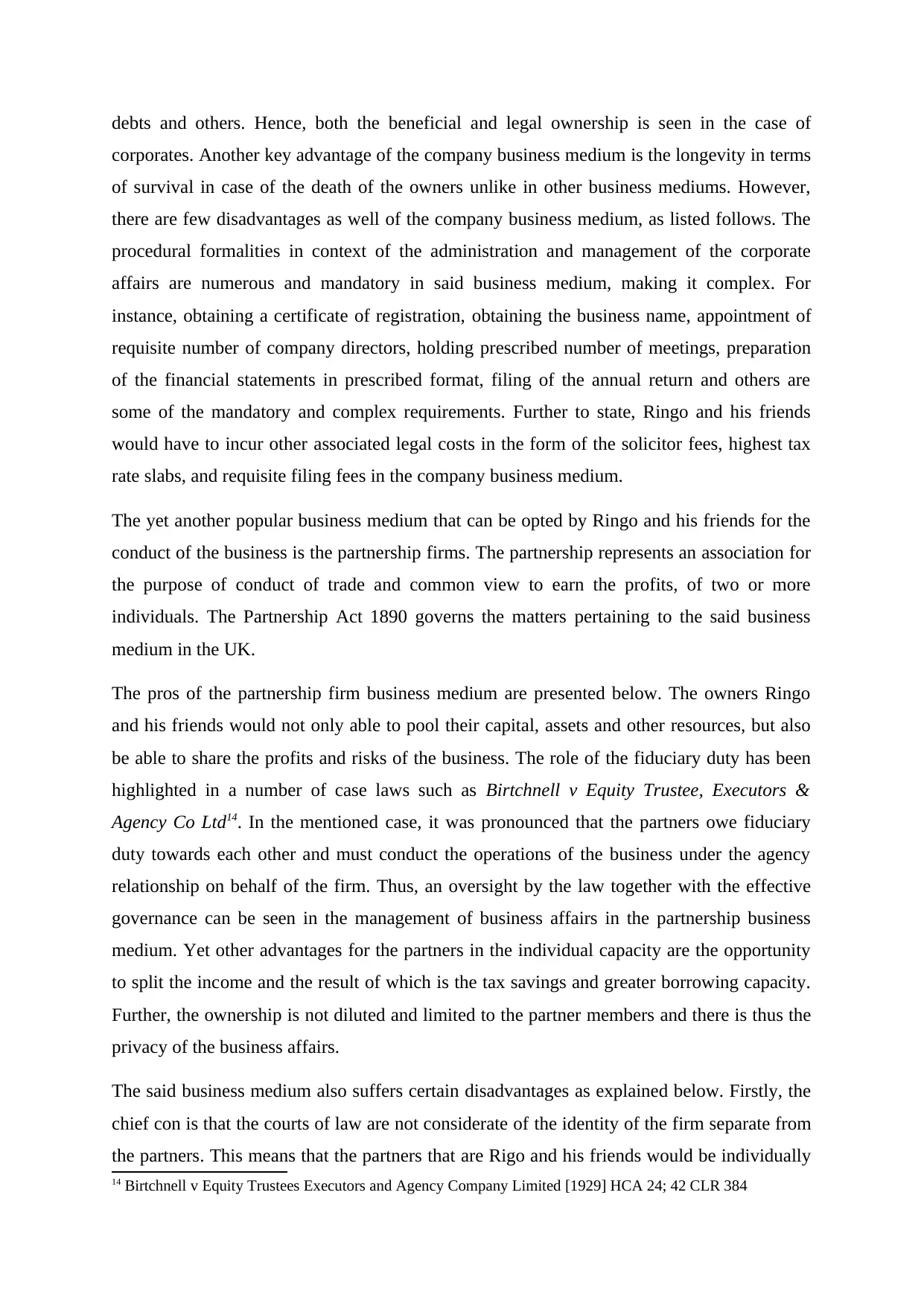
debts and others. Hence, both the beneficial and legal ownership is seen in the case of
corporates. Another key advantage of the company business medium is the longevity in terms
of survival in case of the death of the owners unlike in other business mediums. However,
there are few disadvantages as well of the company business medium, as listed follows. The
procedural formalities in context of the administration and management of the corporate
affairs are numerous and mandatory in said business medium, making it complex. For
instance, obtaining a certificate of registration, obtaining the business name, appointment of
requisite number of company directors, holding prescribed number of meetings, preparation
of the financial statements in prescribed format, filing of the annual return and others are
some of the mandatory and complex requirements. Further to state, Ringo and his friends
would have to incur other associated legal costs in the form of the solicitor fees, highest tax
rate slabs, and requisite filing fees in the company business medium.
The yet another popular business medium that can be opted by Ringo and his friends for the
conduct of the business is the partnership firms. The partnership represents an association for
the purpose of conduct of trade and common view to earn the profits, of two or more
individuals. The Partnership Act 1890 governs the matters pertaining to the said business
medium in the UK.
The pros of the partnership firm business medium are presented below. The owners Ringo
and his friends would not only able to pool their capital, assets and other resources, but also
be able to share the profits and risks of the business. The role of the fiduciary duty has been
highlighted in a number of case laws such as Birtchnell v Equity Trustee, Executors &
Agency Co Ltd14. In the mentioned case, it was pronounced that the partners owe fiduciary
duty towards each other and must conduct the operations of the business under the agency
relationship on behalf of the firm. Thus, an oversight by the law together with the effective
governance can be seen in the management of business affairs in the partnership business
medium. Yet other advantages for the partners in the individual capacity are the opportunity
to split the income and the result of which is the tax savings and greater borrowing capacity.
Further, the ownership is not diluted and limited to the partner members and there is thus the
privacy of the business affairs.
The said business medium also suffers certain disadvantages as explained below. Firstly, the
chief con is that the courts of law are not considerate of the identity of the firm separate from
the partners. This means that the partners that are Rigo and his friends would be individually
14 Birtchnell v Equity Trustees Executors and Agency Company Limited [1929] HCA 24; 42 CLR 384
corporates. Another key advantage of the company business medium is the longevity in terms
of survival in case of the death of the owners unlike in other business mediums. However,
there are few disadvantages as well of the company business medium, as listed follows. The
procedural formalities in context of the administration and management of the corporate
affairs are numerous and mandatory in said business medium, making it complex. For
instance, obtaining a certificate of registration, obtaining the business name, appointment of
requisite number of company directors, holding prescribed number of meetings, preparation
of the financial statements in prescribed format, filing of the annual return and others are
some of the mandatory and complex requirements. Further to state, Ringo and his friends
would have to incur other associated legal costs in the form of the solicitor fees, highest tax
rate slabs, and requisite filing fees in the company business medium.
The yet another popular business medium that can be opted by Ringo and his friends for the
conduct of the business is the partnership firms. The partnership represents an association for
the purpose of conduct of trade and common view to earn the profits, of two or more
individuals. The Partnership Act 1890 governs the matters pertaining to the said business
medium in the UK.
The pros of the partnership firm business medium are presented below. The owners Ringo
and his friends would not only able to pool their capital, assets and other resources, but also
be able to share the profits and risks of the business. The role of the fiduciary duty has been
highlighted in a number of case laws such as Birtchnell v Equity Trustee, Executors &
Agency Co Ltd14. In the mentioned case, it was pronounced that the partners owe fiduciary
duty towards each other and must conduct the operations of the business under the agency
relationship on behalf of the firm. Thus, an oversight by the law together with the effective
governance can be seen in the management of business affairs in the partnership business
medium. Yet other advantages for the partners in the individual capacity are the opportunity
to split the income and the result of which is the tax savings and greater borrowing capacity.
Further, the ownership is not diluted and limited to the partner members and there is thus the
privacy of the business affairs.
The said business medium also suffers certain disadvantages as explained below. Firstly, the
chief con is that the courts of law are not considerate of the identity of the firm separate from
the partners. This means that the partners that are Rigo and his friends would be individually
14 Birtchnell v Equity Trustees Executors and Agency Company Limited [1929] HCA 24; 42 CLR 384
⊘ This is a preview!⊘
Do you want full access?
Subscribe today to unlock all pages.

Trusted by 1+ million students worldwide
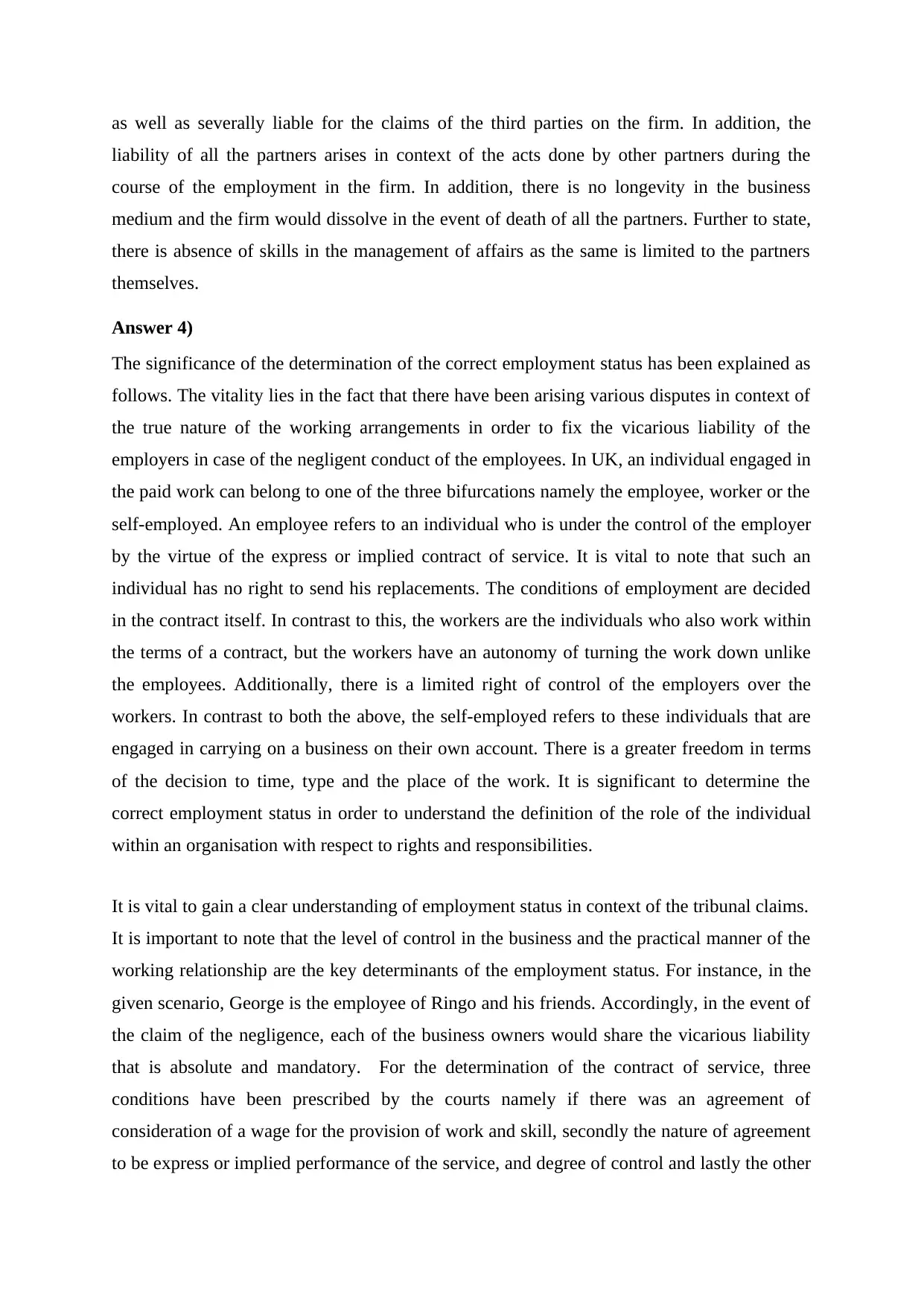
as well as severally liable for the claims of the third parties on the firm. In addition, the
liability of all the partners arises in context of the acts done by other partners during the
course of the employment in the firm. In addition, there is no longevity in the business
medium and the firm would dissolve in the event of death of all the partners. Further to state,
there is absence of skills in the management of affairs as the same is limited to the partners
themselves.
Answer 4)
The significance of the determination of the correct employment status has been explained as
follows. The vitality lies in the fact that there have been arising various disputes in context of
the true nature of the working arrangements in order to fix the vicarious liability of the
employers in case of the negligent conduct of the employees. In UK, an individual engaged in
the paid work can belong to one of the three bifurcations namely the employee, worker or the
self-employed. An employee refers to an individual who is under the control of the employer
by the virtue of the express or implied contract of service. It is vital to note that such an
individual has no right to send his replacements. The conditions of employment are decided
in the contract itself. In contrast to this, the workers are the individuals who also work within
the terms of a contract, but the workers have an autonomy of turning the work down unlike
the employees. Additionally, there is a limited right of control of the employers over the
workers. In contrast to both the above, the self-employed refers to these individuals that are
engaged in carrying on a business on their own account. There is a greater freedom in terms
of the decision to time, type and the place of the work. It is significant to determine the
correct employment status in order to understand the definition of the role of the individual
within an organisation with respect to rights and responsibilities.
It is vital to gain a clear understanding of employment status in context of the tribunal claims.
It is important to note that the level of control in the business and the practical manner of the
working relationship are the key determinants of the employment status. For instance, in the
given scenario, George is the employee of Ringo and his friends. Accordingly, in the event of
the claim of the negligence, each of the business owners would share the vicarious liability
that is absolute and mandatory. For the determination of the contract of service, three
conditions have been prescribed by the courts namely if there was an agreement of
consideration of a wage for the provision of work and skill, secondly the nature of agreement
to be express or implied performance of the service, and degree of control and lastly the other
liability of all the partners arises in context of the acts done by other partners during the
course of the employment in the firm. In addition, there is no longevity in the business
medium and the firm would dissolve in the event of death of all the partners. Further to state,
there is absence of skills in the management of affairs as the same is limited to the partners
themselves.
Answer 4)
The significance of the determination of the correct employment status has been explained as
follows. The vitality lies in the fact that there have been arising various disputes in context of
the true nature of the working arrangements in order to fix the vicarious liability of the
employers in case of the negligent conduct of the employees. In UK, an individual engaged in
the paid work can belong to one of the three bifurcations namely the employee, worker or the
self-employed. An employee refers to an individual who is under the control of the employer
by the virtue of the express or implied contract of service. It is vital to note that such an
individual has no right to send his replacements. The conditions of employment are decided
in the contract itself. In contrast to this, the workers are the individuals who also work within
the terms of a contract, but the workers have an autonomy of turning the work down unlike
the employees. Additionally, there is a limited right of control of the employers over the
workers. In contrast to both the above, the self-employed refers to these individuals that are
engaged in carrying on a business on their own account. There is a greater freedom in terms
of the decision to time, type and the place of the work. It is significant to determine the
correct employment status in order to understand the definition of the role of the individual
within an organisation with respect to rights and responsibilities.
It is vital to gain a clear understanding of employment status in context of the tribunal claims.
It is important to note that the level of control in the business and the practical manner of the
working relationship are the key determinants of the employment status. For instance, in the
given scenario, George is the employee of Ringo and his friends. Accordingly, in the event of
the claim of the negligence, each of the business owners would share the vicarious liability
that is absolute and mandatory. For the determination of the contract of service, three
conditions have been prescribed by the courts namely if there was an agreement of
consideration of a wage for the provision of work and skill, secondly the nature of agreement
to be express or implied performance of the service, and degree of control and lastly the other
Paraphrase This Document
Need a fresh take? Get an instant paraphrase of this document with our AI Paraphraser
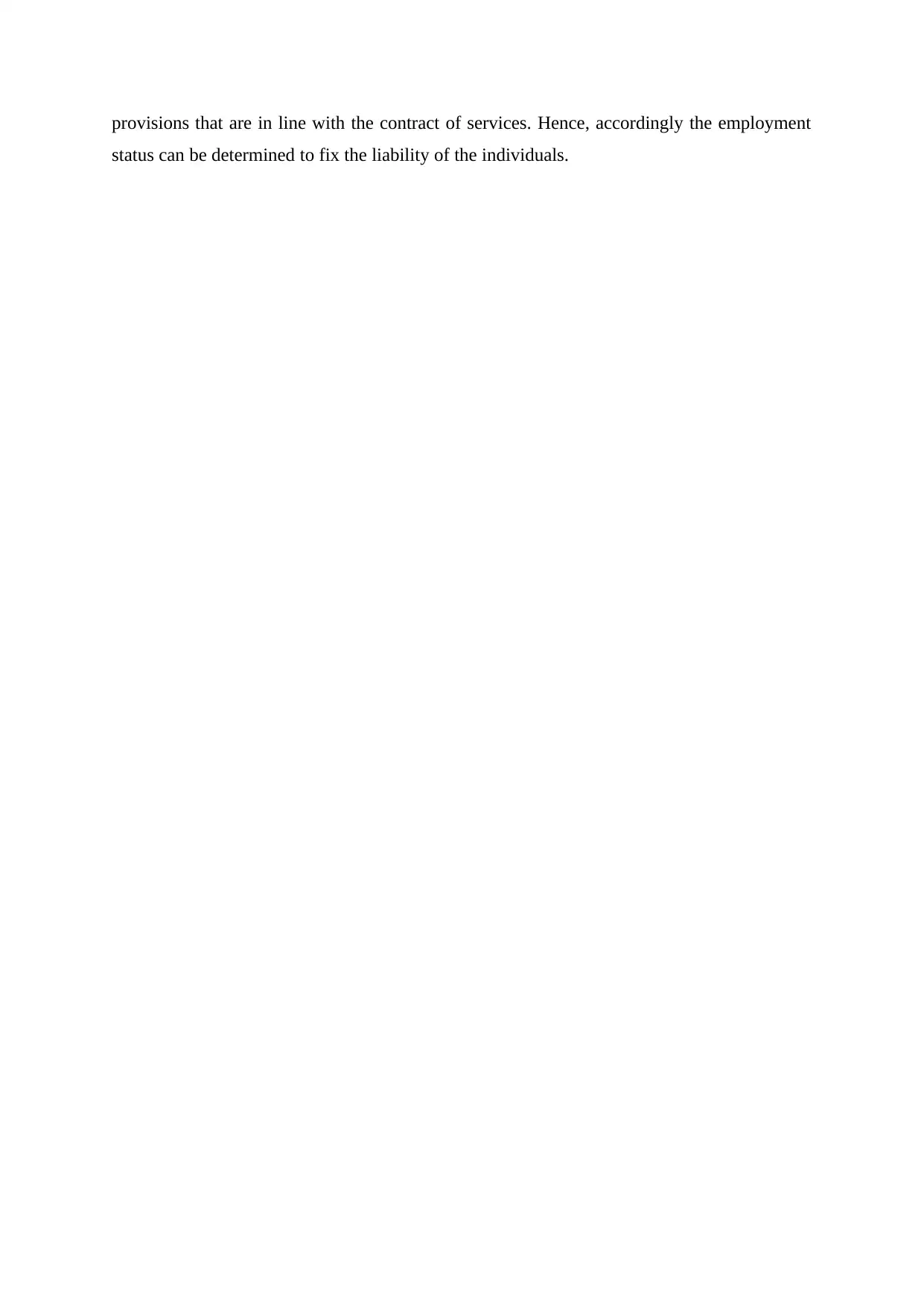
provisions that are in line with the contract of services. Hence, accordingly the employment
status can be determined to fix the liability of the individuals.
status can be determined to fix the liability of the individuals.
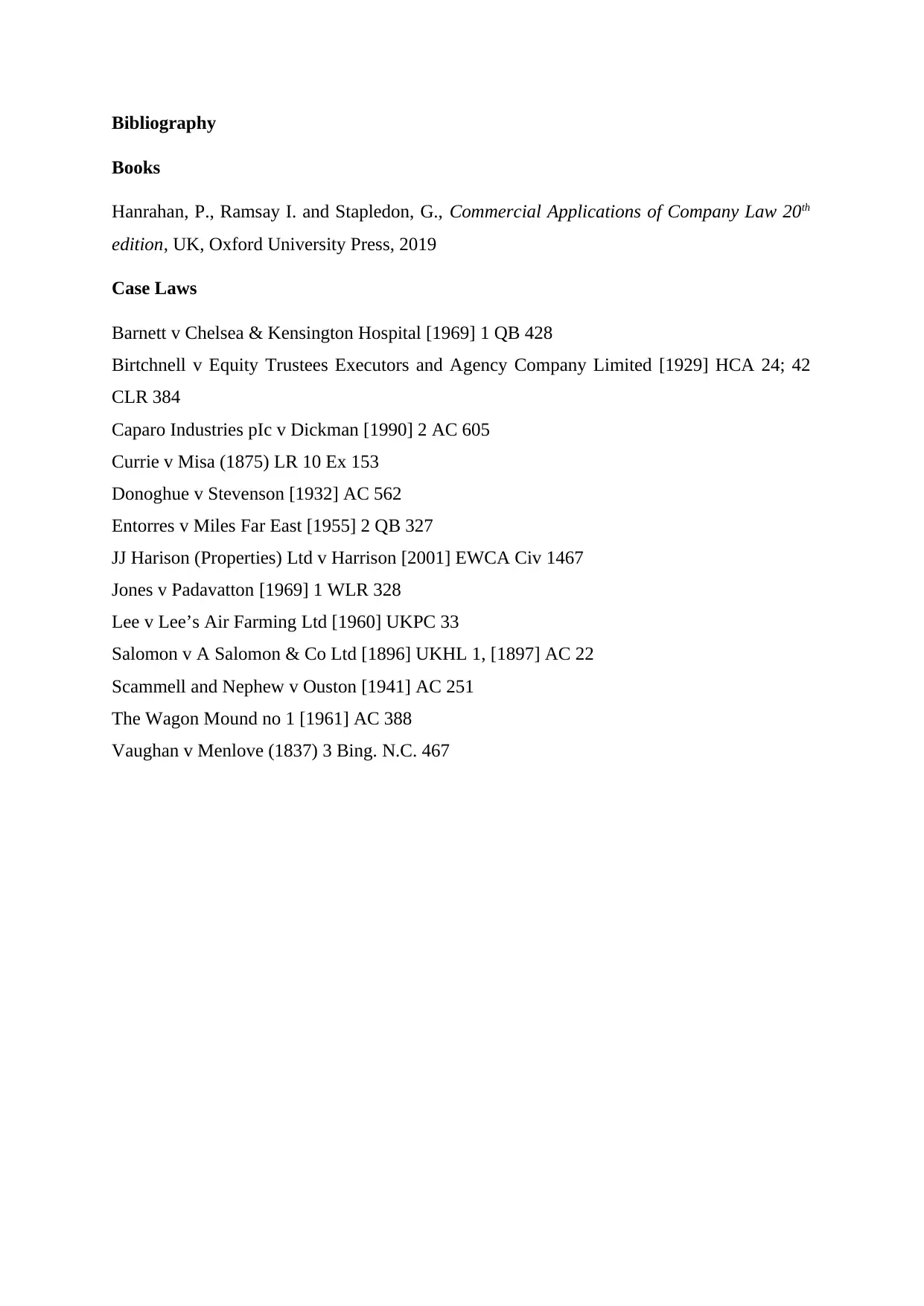
Bibliography
Books
Hanrahan, P., Ramsay I. and Stapledon, G., Commercial Applications of Company Law 20th
edition, UK, Oxford University Press, 2019
Case Laws
Barnett v Chelsea & Kensington Hospital [1969] 1 QB 428
Birtchnell v Equity Trustees Executors and Agency Company Limited [1929] HCA 24; 42
CLR 384
Caparo Industries pIc v Dickman [1990] 2 AC 605
Currie v Misa (1875) LR 10 Ex 153
Donoghue v Stevenson [1932] AC 562
Entorres v Miles Far East [1955] 2 QB 327
JJ Harison (Properties) Ltd v Harrison [2001] EWCA Civ 1467
Jones v Padavatton [1969] 1 WLR 328
Lee v Lee’s Air Farming Ltd [1960] UKPC 33
Salomon v A Salomon & Co Ltd [1896] UKHL 1, [1897] AC 22
Scammell and Nephew v Ouston [1941] AC 251
The Wagon Mound no 1 [1961] AC 388
Vaughan v Menlove (1837) 3 Bing. N.C. 467
Books
Hanrahan, P., Ramsay I. and Stapledon, G., Commercial Applications of Company Law 20th
edition, UK, Oxford University Press, 2019
Case Laws
Barnett v Chelsea & Kensington Hospital [1969] 1 QB 428
Birtchnell v Equity Trustees Executors and Agency Company Limited [1929] HCA 24; 42
CLR 384
Caparo Industries pIc v Dickman [1990] 2 AC 605
Currie v Misa (1875) LR 10 Ex 153
Donoghue v Stevenson [1932] AC 562
Entorres v Miles Far East [1955] 2 QB 327
JJ Harison (Properties) Ltd v Harrison [2001] EWCA Civ 1467
Jones v Padavatton [1969] 1 WLR 328
Lee v Lee’s Air Farming Ltd [1960] UKPC 33
Salomon v A Salomon & Co Ltd [1896] UKHL 1, [1897] AC 22
Scammell and Nephew v Ouston [1941] AC 251
The Wagon Mound no 1 [1961] AC 388
Vaughan v Menlove (1837) 3 Bing. N.C. 467
⊘ This is a preview!⊘
Do you want full access?
Subscribe today to unlock all pages.

Trusted by 1+ million students worldwide
1 out of 9
Related Documents
Your All-in-One AI-Powered Toolkit for Academic Success.
+13062052269
info@desklib.com
Available 24*7 on WhatsApp / Email
![[object Object]](/_next/static/media/star-bottom.7253800d.svg)
Unlock your academic potential
Copyright © 2020–2025 A2Z Services. All Rights Reserved. Developed and managed by ZUCOL.





